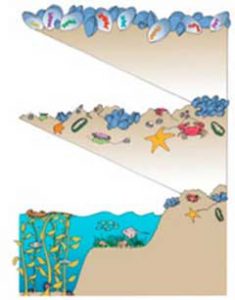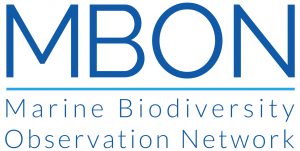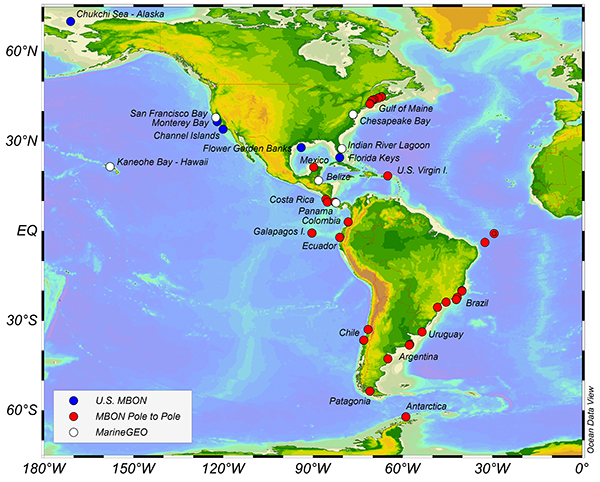
Background
Please visit U.S. MBON at marinebon.org.

MBON is interested in all levels of diversity, as depicted in this diagram. The lower level includes habitat types within a region; the middle level includes species diversity; and the upper level includes genetic diversity within species (Credit: Palumbi et al.).
Biodiversity is critical from the perspective of ecosystem services such as food, oxygen, and socio-economic benefits that support human livelihoods. The Census of Marine Life, which concluded in 2010, greatly enhanced our understanding of the status of marine biodiversity. It also made clear the importance of clear-cut, systematic and sustainable approaches to observing and monitoring biodiversity across different levels and at a national scale. Biodiversity is critical from the perspective of ecosystem services such as food, oxygen, and socio-economic benefits that support human livelihoods. The Census of Marine Life, which concluded in 2010, greatly enhanced our understanding of the status of marine biodiversity. It also made clear the importance of clear-cut, systematic and sustainable approaches to observing and monitoring biodiversity across different levels and at a national scale.
In May 2010, NOAA co-sponsored – with six other federal agencies and the National Oceanographic Partnership Program (NOPP) – a workshop of experts to develop a plan and recommendations for attaining an operational marine biodiversity observation network (MBON) for the nation. The full workshop report is available on the NOPP website or as a PDF.
As an outcome of this workshop, NOAA, NASA, and BOEM initiated a series of projects towards development of a US MBON. US MBON project information and news items are available on marinebon.org.
US MBON partners actively contribute to development of a global MBON and a global biological observing capability, working closely with the Group on Earth Observations Biodiversity Observation Network, the Global Ocean Observing System (GOOS) Biology and Ecosystem Panel, and the Ocean Biodiversity Information System (OBIS), among many other network partners. The three groups signed a letter of agreement in Fall 2016 committing to coordination of a global MBON.
Developing MBON: Demonstration Projects and Partnerships
In October 2014, NOAA, NASA, and the U.S. Department of Interior’s Bureau of Ocean Energy Management (BOEM) initiated the first U.S. network to monitor marine biodiversity for species ranging from microbes to whales. The US Marine Biodiversity Observation Network, or US MBON, was intended as a follow on to the Census of Marine Life.
From 2014-2018, three demonstration projects collaborated to provide a prototype of how a US MBON could be developed. Selected through a National Oceanographic Partnership Program (NOPP) competitive process, the projects worked in multiple geographic areas (Florida Keys National Marine Sanctuary, Monterey Bay National Marine Sanctuary, Santa Barbara Channel and the Channel Islands National Marine Sanctuary, and Alaska’s Chukchi Sea) to integrate data on large-scale sea-surface conditions with biological observations; integrate in situ with satellite data; explore use of new methods and technologies such as automated image processing and environmental DNA, and improve access to integrated biodiversity data.
In October 2019, the US MBON government sponsors (U.S. Integrated Ocean Observing System/US IOOS, National Oceanic and Atmospheric Administration/NOAA, National Aeronautics and Space Administration/NASA, Office of Naval Research/ONR and Bureau of Ocean Energy Management/BOEM) awarded six new three-year U.S. MBON projects to continue development of the Network and to expand geographic coverage.
 Official websites use .gov
A .gov website belongs to an official government organization in the United States.
Official websites use .gov
A .gov website belongs to an official government organization in the United States. Secure .gov websites use HTTPS
A lock or https:// means you’ve safely connected to the .gov website. Share sensitive information only on official, secure websites..
Secure .gov websites use HTTPS
A lock or https:// means you’ve safely connected to the .gov website. Share sensitive information only on official, secure websites..

